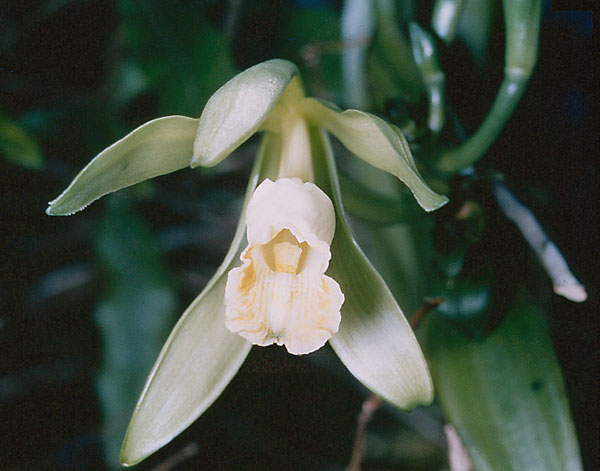- Vanilla (genus)
image_width = 250px
image_caption = "Vanilla planifolia"
fossil_range = fossil range|70The end ofLate Cretaceous orPaleocene (60 - 70 millions of years ago) - Recent
regnum =Plant ae
divisio = Magnoliophyta
classis = Liliopsida
ordo =Asparagales
familia =Orchidaceae
subfamilia =Vanilloideae
tribus = Vanilleae
subtribus = Vanillinae
genus = "Vanilla" (Plumier ex. Mill.,1754 )
subdivision_ranks = Species
subdivision =
List of "Vanilla" species"Vanilla" is a
genus of about 110 species in the orchid family (Orchidaceae ), including the species "Vanilla planifolia" from which commercialvanilla flavoring is derived. The name came from the Spanish word "vainilla", diminutive form of "vaina" (meaning "sheath "), which is in turn derived fromLatin "vagina ".This evergreen genus occurs worldwide in tropical and subtropical regions, from tropical America to tropical Asia, New Guinea and West Africa. It was known to the
Aztec s for its flavoring qualities. It is also grown commercially (esp. "Vanilla planifolia", "Vanilla pompona" and "Vanilla tahitensis").This genus ofvine -like plants has amonopodial climbing habit. They can form long vines with a length of more than 35 m, with alternate leaves spread along its length. The short, oblong, dark green leaves of the "Vanilla" are thick and leathery, even fleshy in some species, though there are a significant number of species that have their leaves reduced to scales or have become nearly or totally leafless and appear to use their green climbing stems forphotosynthesis . Long and strongaerial root s grow from each node.The racemose
inflorescence s short-livedflower s arise successively on short peduncles from the leaf axils or scales. There may be up to 100 flowers on a single raceme, but usually no more than 20. The flowers are quite large and attractive with white, green, greenish yellow or cream colors. Theirsepal s andpetal s are similar. Each flower opens up in the morning and closes late in the afternoon, never to re-open. If pollination has not occurred meanwhile, it will be shed.The lip is tubular-shaped and surrounds the long, bristly column, opening up, as the bell of a trumpet, at its apex. The
anther is at the top of the column and hangs over the stigma, separated by the rostellum. Blooming occurs only when the flowers are fully grown. Most species have a sweet scent. The flowers are self-fertile but need pollinators to perform this task. The flowers are presumed to be pollinated by stingless bees and certain hummingbirds, which visit the flowers primarily for itsnectar . But hand pollination is the best method in commercially grown "Vanilla".The fruit ('vanilla bean') is an elongate, fleshy seed pod 10-20 cm long. It ripens gradually (8 to 9 months after flowering), eventually turning black in color and giving off a strong aroma. Each pod contains thousands of minute seeds, but it is the pod that is used to create vanilla flavoring. Significantly, "Vanilla planifolia" is the only orchid used for industrial purposes (in the food industry and in the cosmetic industry)."Vanilla" species are used as food plants by the
larva e of someLepidoptera species including "Hypercompe eridanus" and "Hypercompe icasia".pecies with common names
* "
Vanilla aphylla ": Leafless Vanilla
* "Vanilla barbellata ": Small Bearded Vanilla, Wormvine Orchid, Leafless Vanilla, Snake Orchid.
* "Vanilla chamissonis ": Chamisso's Vanilla
* "Vanilla claviculata ": Green Withe
* "Vanilla dilloniana ": Leafless Vanilla
* "Vanilla edwallii ": Edwall's Vanilla
* "Vanilla mexicana ": Mexican Vanilla
* "Vanilla odorata ": Inflated Vanilla
* "Vanilla phaeantha ": Leafy Vanilla
* "Vanilla planifolia ": Vanilla, Flat-plane Leaved Vanilla, West Indian Vanilla
* "Vanilla poitaei ": Poiteau's Vanilla
* "Vanilla pompona "
* "Vanilla siamensis ": Thai Vanilla
* "Vanilla tahitensis ": Tahitian Vanilla (synonym of Vanilla planifolia Jacks. ex Andrews )External links
* [http://www.henriettesherbal.com/eclectic/kings/vanilla.html Overview of Vanilla, from King's American Dispensatory, 1898]
* [http://vanilla.servolux.nl/ All you ever wanted to know about vanilla but were afraid to ask]
Wikimedia Foundation. 2010.

